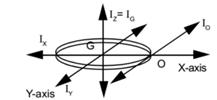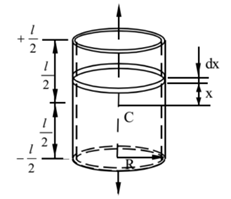Science > Physics > Rotational Motion > Numerical Problems on Moment of Inertia and Radius of Gyration In this article, we shall study to solve problems of calculation of moment of inertia, the radius of gyration, and torque acting on a rotating body. Example – 01: A thin uniform rod of length 1 m and […]

Science > Physics > Rotational Motion > Applications of Parallel and Perpendicular Axes Theorems The parallel axes theorem states that ” The moment of inertia of a rigid body about any axis is equal to the sum of its moment of inertia about a parallel axis through its centre of mass and the product of […]
Moment of Inertia of Standard Bodies

Science > Physics > Rotational Motion Moment of Inertia of Standard Bodies In this article, we shall study the method of deriving an expression for moment of inertia of a body. Expression for Moment of Inertia of Uniform Rod About a Transverse Axis Passing Through its Centre: Consider a thin uniform rod, of mass M, […]
Artificial Satellites
Science > Physics > Astronomical Physics > Artificial Satellites In this article, we shall study about artificial satellites and their uses. Natural satellites are heavenly bodies revolving around a planet in their fixed orbits. They are comparatively larger in size and their orbits have larger radii. Their surfaces are made of rocky mountains or gas. […]
Science > Physics > Astronomical Physics > The Moon The moon revolves around the earth. it is known as the satellite of the Earth. It is the natural satellite of the earth. It is the nearest heavenly body to the earth. It is the brightest object in the night sky. The average distance of it […]
Our Solar System
Science > Physics > Astronomical Physics > Our Solar System The Sun, the eight planets that revolve around it, their satellites, asteroids, and comets all together form our solar system. In the universe, there may be many stars with their own solar system. The sun is the centre of our solar system. All the objects […]
Science > Physics > Astronomical Physics > Stars The stars, the planets, the moon and many other objects in the sky are called celestial or heavenly bodies. The universe includes everything that exists. A cluster of stars is called Galaxy. A galaxy contains billions of stars. Galaxies exist in different shapes. Our galaxy is called […]
Our Galaxy (Milky way / Akashganga)
Science > Physics > Astronomical Physics > Our Galaxy The stars, the planets, the moon and many other objects in the sky are called celestial or heavenly bodies. The universe includes everything that exists. The branch of science that deals with the study of the universe is called astronomy. The Big Bang Theory is the […]
Property Crimes

Indian Legal System > Legal Concepts > Criminology > Concept of Crime > Property Crimes In this article, we shall discuss what is meant by property crimes and various forms of property crimes. Property crimes are crimes that do not necessarily involve harm to another person. Although they may involve physical or mental harm to […]
Scalar Product And Vector Product

Science > Physics > Scalars and Vectors > Scalar Product And Vector Product In this article, we shall study two types of products of vectors: a) Scalar product and b) Vector product Scalar Product of Two Vectors: The scalar or dot product of two vectors is defined as the product of magnitudes of the two […]